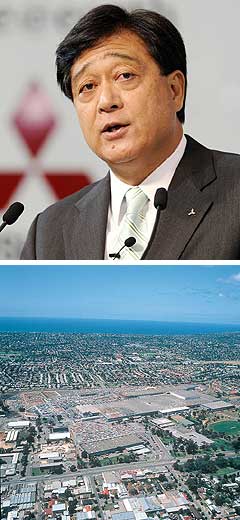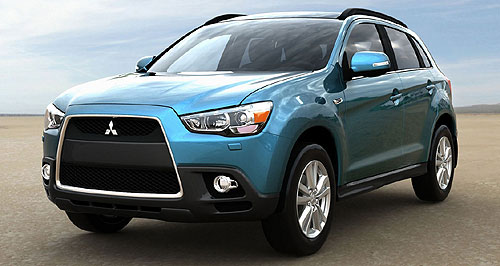Make / Model Search
News - MitsubishiChinese Mitsubishis not for OzMitsubishi's next stock exchange: MMC president Osamu Masuko with the company's next all-new model, the ASX compact crossover due here in July. Mitsubishi seeks joint-venture in China but rules out Chinese models for Australia4 Jun 2010 MITSUBISHI has committed to establishing a joint-venture company in China, but says it will not import Chinese-built vehicles to Australia. Japan’s number six auto-maker remains one of the few mainstream vehicle brands not to have a 50/50 interest in the world’s largest car market, which requires foreign companies to operate in partnership with domestic makers. Mitsubishi Motors Corporation currently holds a 28.5 per cent stake in China’s Southeast (Fujian) Motor Company and a 14.6 per cent share of China’s GAC Changfeng Motor, but has said it hopes to establish a 50/50 partnership in China this year. As a result, Mitsubishi has forecast Chinese domestic sales of 300,000 vehicles by 2015 – more than double the relatively small number of 125,000 vehicles it produced there in 2009. Off a low base, MMC also plans to increase Chinese vehicle sales by more than 45 per cent in 2010, to 180,000 vehicles. Guangzhou Motors (GAC) last year bought a 29 per cent stake in Changfeng, reducing the influence of Mitsubishi in the company, but MMC has denied reports it plans to reduce its interest in Changfeng. Instead, MMC president Osamu Masuko says his company remains committed to establishing a joint-venture arrangement in China to have greater control over its destiny in the world’s fastest growing economy. “We are now discussing with our partner to increase our share to 50 per cent (in China),” said Mr Masuko in Sydney on Wednesday, adding that its current interest in Chinese car-makers was “too small” to be influential. “We have two assembly plants… but we cannot manage those companies with such a small interest in them. “(But) We have no plan to export from China to Australia," said Mr Masuko (below).  Ironically, Mitsubishi Motors Australia Limited, which ceased local vehicle production (of the 380 sedan) two years ago, only in recently shipped its large body stamping press to an unspecified buyer in China. Ironically, Mitsubishi Motors Australia Limited, which ceased local vehicle production (of the 380 sedan) two years ago, only in recently shipped its large body stamping press to an unspecified buyer in China.The removal of the last piece of manufacturing equipment from its former Tonsley Park assembly plant (left) outside Adelaide followed a clear-out of machinery over the past 18 months, prior to a formal handover of the facility to its new owner, the South Australian state government, on December 16. Mr Masuko said MMC’s decision to cease manufacturing in Australia was difficult but unavoidable. “Because we built cars in Australia for such a long period of time it was a difficult decision to make,” he said. “In 2004 the Mitsubishi parent company itself was not in the best financial shape, therefore it was seen that it was not viable for Mitsubishi to support Australian manufacturing. “This was a financial decision. It was not because we didn’t want to produce in Australia any more as a company.” Mitsubishi vehicle sales in China were up more than 50 per cent and increased by five per cent overall in Asia last year, when MMC returned to profit, but the company’s global sales remained down 10 per cent in 2009. In Australia, where Mitsubishi is now also operating profitably, sales are up by almost 25 per cent so far this year – outstripping the overall industry recovery - following 53 and 46 per cent sales increases in April and may respectively. MMC and PSA Peugeot Citroen announced in March that they had ended negotiations to establish an industrial alliance, but would continue to share products such as the closely related Mitsubishi Outlander, Peugeot 4007 and Citroen C-Crosser. Mr Masuko dismissed assertions by some industry experts, including Nissan and Renault chief Carlos Ghosn, that major car-makers could not survive without annual sales volume of four million vehicles. Asked to comment on MMC’s view, an animated Mr Masuko, who became MMC president on July 1, 2009, said: “It’s a very, very good question and after I became president I received the same question so many times. “Size is very important, but just because a company is large that doesn’t mean that it can actually survive. “Although the US big three – GM, Ford and Chrysler - were quite big as companies they weren’t profitable. Although size is an important factor, other key points need to be considered like the development of vehicle technologies, global environmental considerations and what the customer wants and changing market needs. “In 1998 there was a popular belief that if you were not in the four million vehicle club, so to speak… the company would not be able to survive and it would not be able to commit to the R&D that is required. “So that’s why in that period there were a lot of mergers and joint-ventures established. Mitsubishi as well joined with Daimler, Daimler joined with Chrysler and we became quite a big group, but the partnership between Daimler and Chrysler didn’t last very long. “In terms of ventures, capital alliance is important, but if the companies do not have the same philosophy or culture in producing vehicles, then that won’t be viable in the long term. “As a business alliance, yes, capital alliances are important, and we will continue to look at that in future, but there are other factors that are also important. “From now on we will also look at many alliances with other companies. However, the future direction is that the business alliance can continue.(only) if our philosophy is the same as another company’s. “At the moment, we are aligned with the (PSA) Peugeot group and also Nissan domestically, and we would like to continue on with those business alliances in future,” said Mr Masuko. MMC increased its total global production to almost 80,000 vehicles in April, representing the sixth consecutive month of increased production and a 27.7 per cent increase on April 2009 figures. Japanese production amounted to more than 40,000 units in April – up 76.1 per cent on the same month last year. Mitsubishi vehicle production in Asia overall was up by almost 110 per cent, following manufacturing increases of 314 per cent in Thailand, 105 per cent in China, 81 per cent in Indonesia and 8.6 per cent in Taiwan. MMC also produces vehicles in North America, South America and Europe.  Read more |
Click to shareMitsubishi articlesResearch Mitsubishi Motor industry news |












Facebook Twitter Instagram